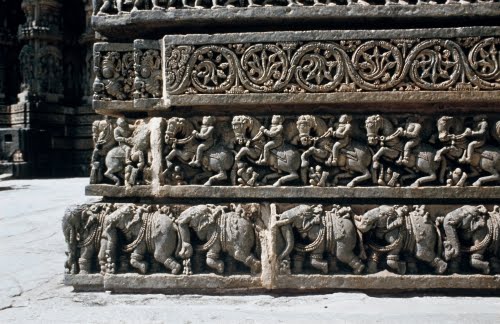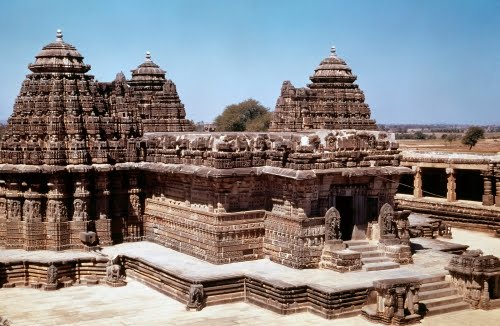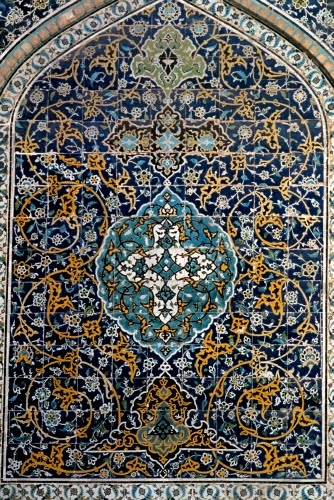It's All in the Details: Hoysala Dynasty and Safavid Dynasty
The sculptural decoration of Hoysala dynasty (ca. 1050–ca. 1346) architecture is particularly ornate and worth scoping out. In the West, we are so inundated with data about the “sculpture programs” of the Parthenon in Athens, etc. Well, I dare say that the sculpture on many Hindu temples equals, if not surpasses, the sophistication and sheer magnificence of Indian art from their so-called medieval period.
Do the repeated horsemen in this deep relief remind you of anything, and yet exceed it in energy? Hmmm, the horsemen of the Panathenaic Procession from the Parthenon? I thought so. These horsemen, not to mention the procession of elephants, make the Parthenon figures look like they’re stuck in cement.
 |
| India, Wall base of the Assembly Hall of Prasanna Chennakesava Temple, Somnathapur, completed around 1268. Image © 2017 Davis Art Images. (8S-10092) |
After the fall of the Gupta Dynasty (ca. 320–643 CE) in northern India, six thriving yet separate kingdoms evolved that flourished for hundreds of years. There was a consolidation of the Hindu kingdoms in southern India, as well, by the 700s CE. One of these dynasties was the Hoysala. The first Hoysala kings came from the hills northwest of present-day Halebid, which became their capital around 1060. By the 1200s, the dynasty was the dominant power in southern India.
Prasanna Chennakesava Temple is unique to Dravidian architecture because the main temple has a flat roof, rather than pyramidal. It is also unusual in that it is a triple shrine dedicated to three aspects of Vishnu. Krsna is particularly venerated there. The temple is sometimes called the Star Temple because it has a sixteen-pointed star plan.
 |
| India, Prasanna Chennakesava Temple, Somnathapur, completed around 1268. Image © 2017 Davis Art Images. (8S-10088) |
****************************************
If the Safavid period was the high point of architecture in Iran, then the Imam Mosque has got to rank as one of the period’s finest achievements. One of the most remarkable aspects of the Imam Mosque is the seven-color ceramic tile decoration which covers it almost entirely. Much of the decoration around the entrance portal, like this example, is formed by multi-colored pieces cut from larger tiles and pieced together to form the complex abstracted floral decoration. In many parts of the dome and minarets, the ceramic was shaped to conform to the curves of the surfaces!
 |
| Iran, Glazed wall tile panel from the courtyard of the Imam Mosque, Isfahan, 1612–1666. Image © 2017 Davis Art Images. (8S-10249) |
After 900 years of disunited and foreign (Seljuk Turk and Mongol) rule, the Safavid dynasty united Iran under Shiism. The rule of Abbas I (died 1629) marked the high point of the Safavid period. He moved the capital from the insecure western border established by the Mongols back to Isfahan in central Iran in 1598. The Safavid period is often considered one of the high points of Iranian art.
In order to shore up Safavid influence and prestige, Abbas planned a massive building program in Isfahan, building some of the most beautiful structures in Islam, and making additions to existing Seljuk structures. His new city extended to the south of existing Isfahan. Succeeding shahs continued the building programs in Isfahan up until the disastrous reign (1694–1722) of the Safavid's last ruler, Hossein Safavi (ca.1668–1726).
 |
| Iran, entrance portal of Imam Mosque, Isfahan, 1612–1666. Image © 2017 Davis Art Images. (8S-10246) |
Other posts in this series:
Federal Style and Early Modernist Architecture
Correlations to Davis Programs: A Personal Journey: 8.4; A Community Connection: 3.4; The Visual Experience: 11.4, 13.2 14.2; Discovering Art History: 4.2, 4.7, 8.2

Comments